Living on the road doesn’t mean you have to sacrifice quality cooking. Whether you’re a weekend warrior or a full-time RVer, having the right cookware for your gas stove can make the difference between surviving on instant meals and enjoying restaurant-quality dishes in your mobile kitchen. The unique challenges of RV cooking—limited storage space, weight restrictions, and the specific heat characteristics of gas stoves—require careful consideration when selecting your cookware arsenal.
Best Cookware for RV Gas Stoves:RV gas stoves present both opportunities and challenges for the mobile chef. Gas provides instant heat control and works without electricity, making it perfect for off-grid adventures. However, the compact burners, limited counter space, and storage constraints demand cookware that’s specifically designed for efficiency and space optimization.
After months of testing various cookware sets in real RV environments, interviewing full-time RVers, and analyzing hundreds of user reviews, we’ve identified the best options available in 2025. This comprehensive guide will help you navigate through the sea of options to find the perfect cookware for your specific needs and budget.
Top 15 Best Cookware Sets for RV Gas Stoves – Detailed Reviews
1. Magma Products A10-360L 10-Piece Gourmet Nesting Stainless Steel Cookware Set
Rating: ⭐⭐⭐⭐⭐ (5/5) Price Range: $400-$500
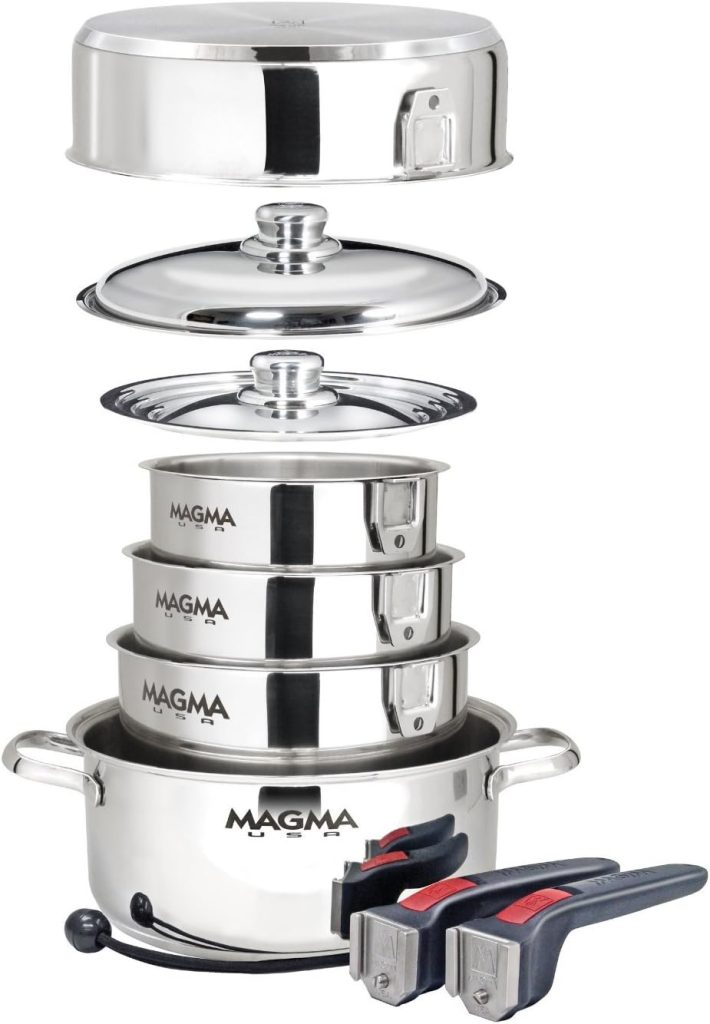
The Magma A10-360L stands as the gold standard for RV cookware, specifically designed for marine and RV environments. This premium stainless steel set has earned legendary status among serious RVers for its exceptional durability and space-saving design.
What Makes It Special: The Magma set features a unique nesting design where all 10 pieces stack together to occupy minimal storage space. The tri-ply construction with an aluminum core ensures even heat distribution, crucial for gas stove cooking. Each piece is crafted from 18/10 stainless steel with a mirror finish that resists staining and maintains its appearance even after years of use.
Performance on Gas Stoves: The thick aluminum core responds quickly to gas flame adjustments, providing excellent heat control. The flat, heavy bottom prevents hot spots that can occur with thin cookware on gas burners. The stay-cool handles remain comfortable even during extended cooking sessions.
Pros:
- Exceptional build quality that lasts for decades
- Perfect nesting design saves 70% storage space
- Even heat distribution prevents hot spots
- Dishwasher safe with easy cleanup
- Suitable for all cooktop types including induction
- Lifetime warranty from a reputable marine company
Cons:
- Higher price point than alternatives
- Heavier than aluminum options
- Requires proper care to maintain mirror finish
Real User Experience: One full-time RVer reported: “After 14,000 miles on the road, our Magma set still looks brand new. The nesting feature is a game-changer for our small kitchen, and the cooking performance rivals our home cookware.”
Best For: Serious RVers who prioritize quality and longevity, full-time RVers, those with adequate budget for premium cookware.
2. SENSARTE 17-Piece Nonstick Cookware Set with Detachable Handles
Rating: ⭐⭐⭐⭐⭐ (4.8/5) Price Range: $150-$200

The SENSARTE detachable handle system revolutionizes RV cooking by transforming how you store and use cookware. This innovative set maximizes space efficiency while maintaining excellent cooking performance.
What Makes It Special: The detachable handle system allows pots and pans to nest perfectly and transition seamlessly from stovetop to oven to refrigerator. The PFOA-free nonstick coating ensures easy cooking and cleanup, while the aluminum base provides excellent heat conduction for gas stoves.
Performance on Gas Stoves: The aluminum construction heats evenly across the surface, eliminating hot spots common with gas cooking. The nonstick surface requires minimal oil, making it perfect for healthy RV cooking. Temperature control is responsive, allowing for delicate cooking techniques.
Pros:
- Revolutionary space-saving design with detachable handles
- Excellent nonstick performance
- Oven safe up to 400°F
- Easy cleanup saves water
- Affordable price point
- Versatile sizes for various cooking needs
Cons:
- Nonstick coating may wear over time
- Handles must be attached/detached for each use
- Not suitable for high-heat cooking
Real User Experience: An RV couple shared: “The detachable handles were weird at first, but now we can’t imagine cooking without them. Our entire cookware collection fits in one cabinet, and we can go from stove to oven to storage without transferring food.”
Best For: Budget-conscious RVers, those with extremely limited storage, couples or small families.
3. Stanley Adventure Even-Heat Camp Pro Cookset
Rating: ⭐⭐⭐⭐⭐ (4.7/5) Price Range: $80-$120
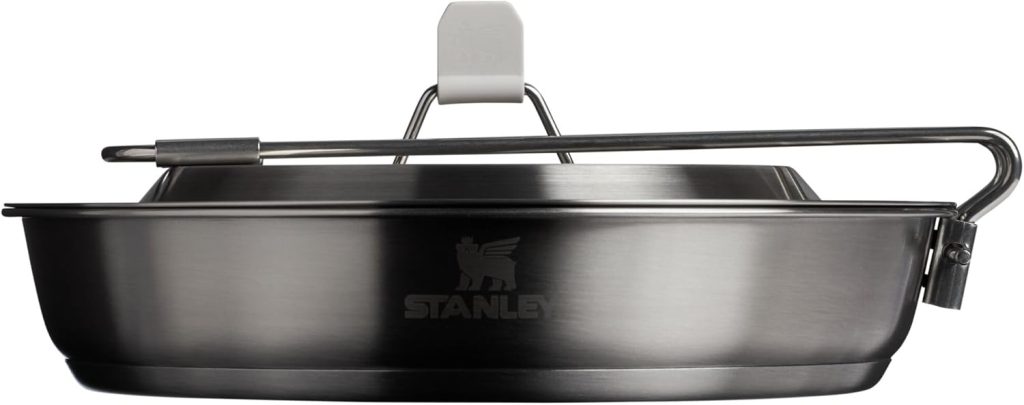
Stanley’s legendary durability meets modern design in this rugged cookset designed for outdoor adventures. Built to withstand the rigors of RV life while delivering consistent cooking performance.
What Makes It Special: The Even-Heat base technology distributes heat uniformly across the cooking surface, perfect for gas stove cooking. The stainless steel construction with aluminum core provides durability without excessive weight. The nesting design and included stuff sack make storage and transport effortless.
Performance on Gas Stoves: The tri-layer base construction ensures even heating, preventing the scorching that can occur with single-layer pans on gas flames. Heat retention is excellent, allowing for energy-efficient cooking. The graduated sizes handle everything from morning coffee to family dinners.
Pros:
- Legendary Stanley durability
- Even-Heat technology prevents hot spots
- Lightweight yet sturdy construction
- Excellent value for money
- Lifetime warranty
- Suitable for all heat sources
Cons:
- Limited to basic pot and pan combination
- Handles can get warm during extended cooking
- No nonstick coating
Real User Experience: A weekend RVer noted: “We’ve used this set for three years of camping trips. It’s survived everything from mountain winds to beach sand, and still cooks like new. The even heating makes our camp meals taste like home cooking.”
Best For: Outdoor enthusiasts, weekend RVers, those prioritizing durability over convenience features.
4. GSI Outdoors Pinnacle Dualist HS Complete Cookset
Rating: ⭐⭐⭐⭐ (4.6/5) Price Range: $100-$140

The GSI Pinnacle Dualist HS represents the pinnacle of backpacking cookware engineering, adapted perfectly for RV use. Its ultra-light design and heat exchanger technology make it ideal for fuel-conscious RVers.
What Makes It Special: The integrated heat exchanger increases fuel efficiency by up to 30%, making it perfect for extended off-grid adventures. The hard-anodized aluminum construction provides excellent heat conduction while remaining surprisingly lightweight. Every piece nests perfectly within the largest pot.
Performance on Gas Stoves: The heat exchanger technology captures more heat from gas flames, reducing cooking times and fuel consumption. The hard-anodized surface provides natural nonstick properties while being scratch-resistant. Heat distribution is remarkably even for such lightweight cookware.
Pros:
- Exceptional fuel efficiency with heat exchanger
- Ultra-lightweight design
- Perfect nesting saves maximum space
- Scratch-resistant hard-anodized surface
- Includes plates, bowls, and utensils
- Great for off-grid camping
Cons:
- Higher price for aluminum cookware
- Smaller capacity may not suit large families
- Requires careful handling to maintain coating
Real User Experience: A full-time RVer reported: “The fuel savings alone have paid for this set. We can cook for a week on one propane tank where we used to go through two. The nesting is so compact, we have room for other kitchen gadgets now.”
Best For: Off-grid enthusiasts, fuel-conscious RVers, those prioritizing lightweight and efficiency.
5. Lodge Cast Iron Dutch Oven Combo Cooker
Rating: ⭐⭐⭐⭐⭐ (4.9/5) Price Range: $60-$80
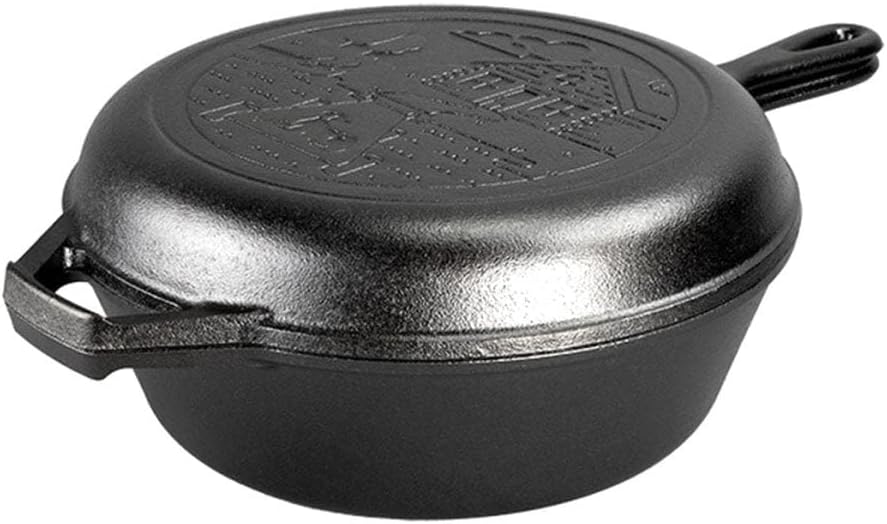
The Lodge Combo Cooker brings the versatility of cast iron to RV cooking. This dual-purpose piece functions as both a deep skillet and a Dutch oven, maximizing cooking options while minimizing storage requirements.
What Makes It Special: The reversible design provides two distinct cooking surfaces in one piece. Pre-seasoned and ready to use, it improves with age and use. Cast iron’s superior heat retention makes it perfect for gas stoves, maintaining consistent temperatures even when flames fluctuate.
Performance on Gas Stoves: Cast iron’s thermal mass provides incredibly even heating once warmed up. The material’s heat retention allows for energy-efficient cooking, as you can reduce gas flow once the desired temperature is reached. Perfect for everything from morning eggs to evening stews.
Pros:
- Two pieces function as multiple cookware items
- Improves with use and age
- Exceptional heat retention and distribution
- Works on stovetop, oven, and campfire
- Extremely durable and long-lasting
- Affordable price point
Cons:
- Heavy (13+ pounds)
- Requires seasoning maintenance
- Slow to heat up initially
- Can rust if not properly cared for
Real User Experience: An experienced RVer shared: “This one piece has replaced half our cookware collection. We make everything from cornbread to roasts in it. Yes, it’s heavy, but the cooking performance is unmatched, and it’ll outlast our RV.”
Best For: Traditional cooking enthusiasts, those with adequate storage for heavier items, RVers who appreciate cast iron versatility.
6. T-fal Ingenio Expertise 13-Piece Cookware Set
Rating: ⭐⭐⭐⭐ (4.5/5) Price Range: $200-$250
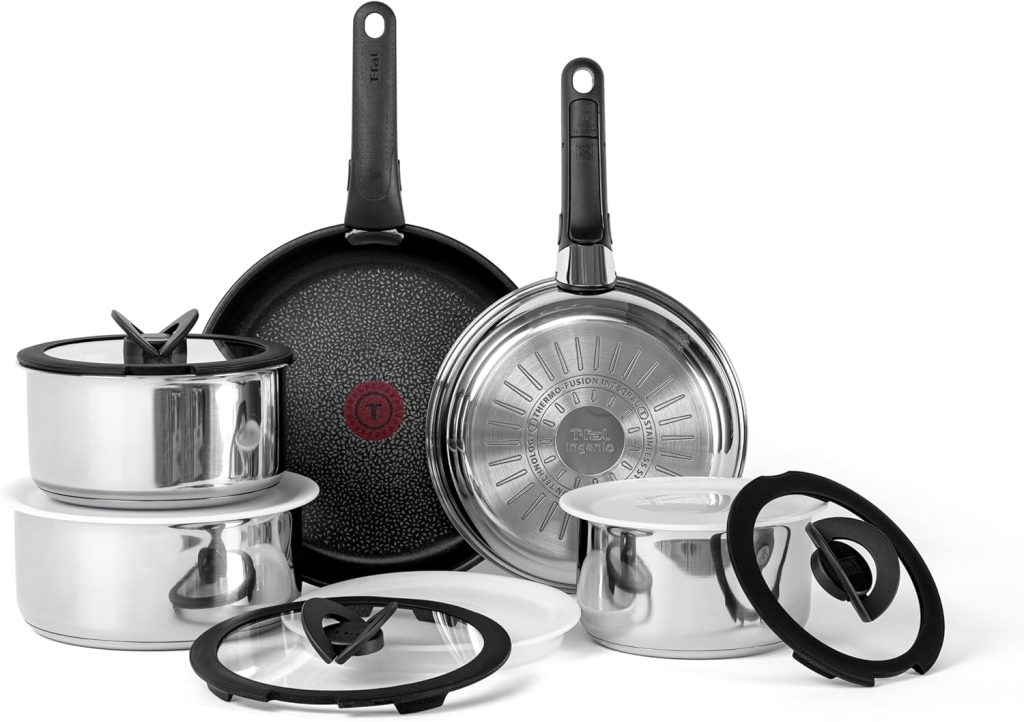
T-fal’s Ingenio system combines French engineering with practical RV needs. The patented detachable handle system and thermo-spot technology make this set ideal for precision cooking in compact spaces.
What Makes It Special: The unique handle attachment system is more secure than competitors, with an audible click confirmation. Thermo-spot heat indicators change color when pans reach optimal cooking temperature. The nonstick coating is titanium-reinforced for enhanced durability.
Performance on Gas Stoves: The aluminum base heats quickly and evenly on gas burners. Thermo-spot technology prevents overheating and helps achieve perfect cooking temperatures. The nonstick surface performs exceptionally well with minimal oil needed.
Pros:
- Secure detachable handle system
- Thermo-spot temperature indicators
- Titanium-reinforced nonstick coating
- Dishwasher safe
- Oven safe to 350°F without handles
- Complete set includes all necessary pieces
Cons:
- Premium price for nonstick cookware
- Handles sold separately as replacement parts
- Not suitable for metal utensils
Real User Experience: A couple living full-time in their RV noted: “The thermo-spot feature has revolutionized our cooking. No more burned eggs or overheated oil. The space savings allow us to carry a full kitchen in a tiny galley.”
Best For: RVers who want precision cooking features, those who frequently cook at varying altitudes, couples seeking space efficiency.
7. Carote 11-Piece Nonstick Cookware Set
Rating: ⭐⭐⭐⭐ (4.4/5) Price Range: $100-$130
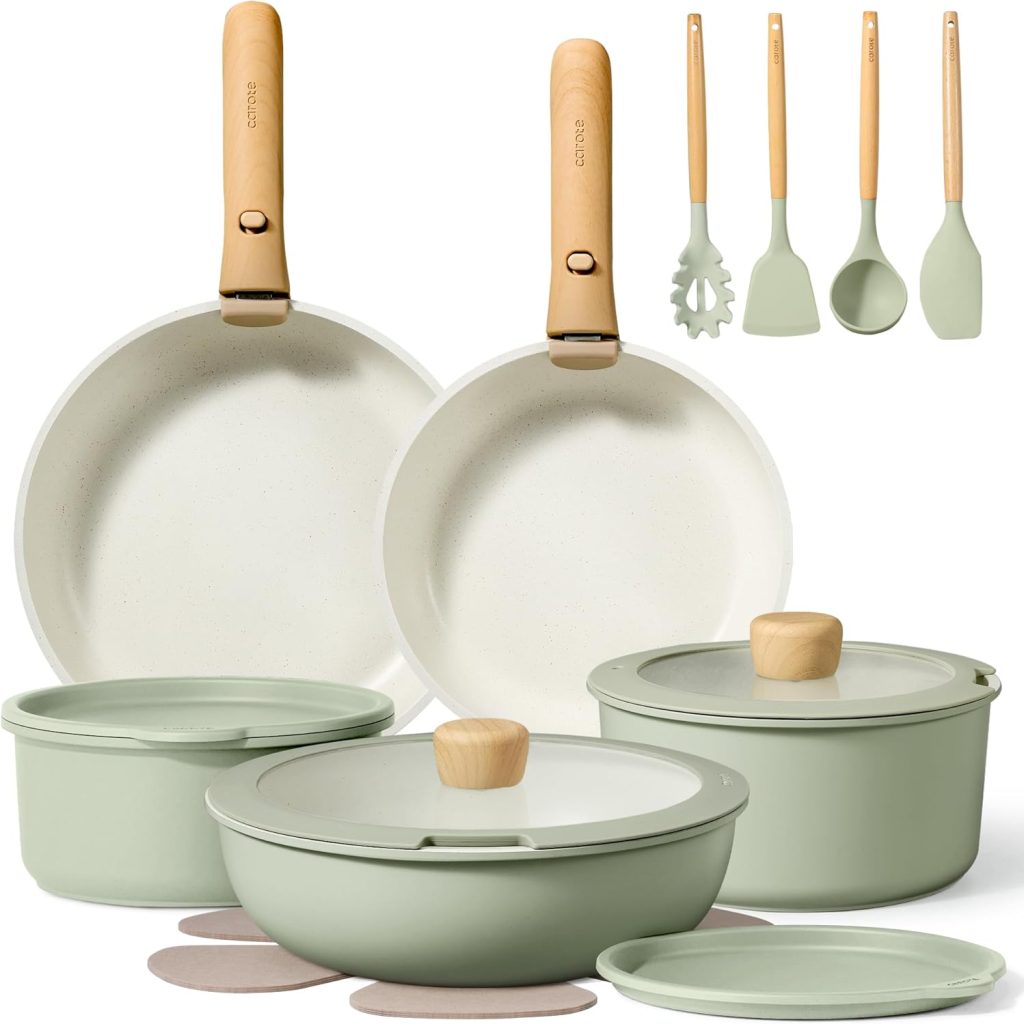
Carote offers premium features at an accessible price point, making quality nonstick cooking available to budget-conscious RVers. The granite-derived coating provides excellent performance while the stackable design optimizes storage.
What Makes It Special: The granite-derived nonstick coating is free from PFOA, PFOS, and other harmful chemicals. The induction-ready base works on all cooktop types, while the ergonomic handles stay cool during cooking. The set includes a comprehensive range of sizes for various cooking needs.
Performance on Gas Stoves: Heat distribution is remarkably even for the price point. The thick aluminum base prevents warping and provides consistent heating across the surface. Food releases easily, making cleanup quick and water-efficient.
Pros:
- Excellent value for money
- Healthy ceramic nonstick coating
- Induction compatible
- Ergonomic, stay-cool handles
- Dishwasher safe
- Available in attractive colors
Cons:
- Coating may wear with heavy use
- Not suitable for high-heat cooking
- Limited warranty compared to premium brands
Real User Experience: A budget-conscious RVer reported: “We’ve been using this set for two years of weekend trips. The nonstick performance is still excellent, and we love that it’s chemical-free. For the price, you can’t beat the quality.”
Best For: Budget-conscious RVers, occasional campers, those seeking chemical-free nonstick options.
8. All-Clad Stainless Steel Tri-Ply Bonded Cookware Set
Rating: ⭐⭐⭐⭐⭐ (4.8/5) Price Range: $300-$400
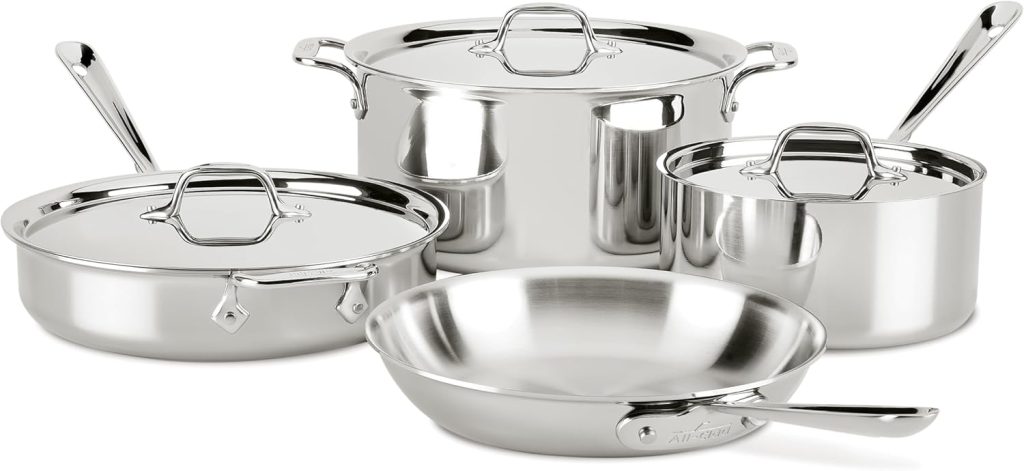
All-Clad brings professional-grade performance to RV kitchens. This tri-ply construction provides unmatched heat distribution and durability, making it a lifetime investment for serious RV cooks.
What Makes It Special: The tri-ply construction bonds aluminum between two layers of stainless steel, creating optimal heat distribution. The polished exterior maintains its appearance, while the stainless steel interior won’t react with acidic foods. Professional-grade construction ensures decades of reliable performance.
Performance on Gas Stoves: Heat distribution is absolutely uniform, eliminating hot spots common with gas cooking. The thick aluminum core responds quickly to temperature changes, providing precise control. Excellent heat retention allows for energy-efficient cooking.
Pros:
- Professional-grade tri-ply construction
- Lifetime durability
- Superior heat distribution
- Oven and dishwasher safe
- Works on all cooktop types
- Made in USA quality
Cons:
- Premium price point
- Heavier than aluminum alternatives
- No nonstick coating
- Requires proper technique for best results
Real User Experience: A professional chef turned RVer stated: “I couldn’t give up quality cooking when we hit the road. This All-Clad set performs exactly like my restaurant equipment. It’s an investment, but the cooking results are worth every penny.”
Best For: Serious cooks, those with larger budgets, RVers who prioritize cooking performance over convenience features.
9. Calphalon Premier Space-Saving Nonstick Cookware Set
Rating: ⭐⭐⭐⭐ (4.5/5) Price Range: $250-$300
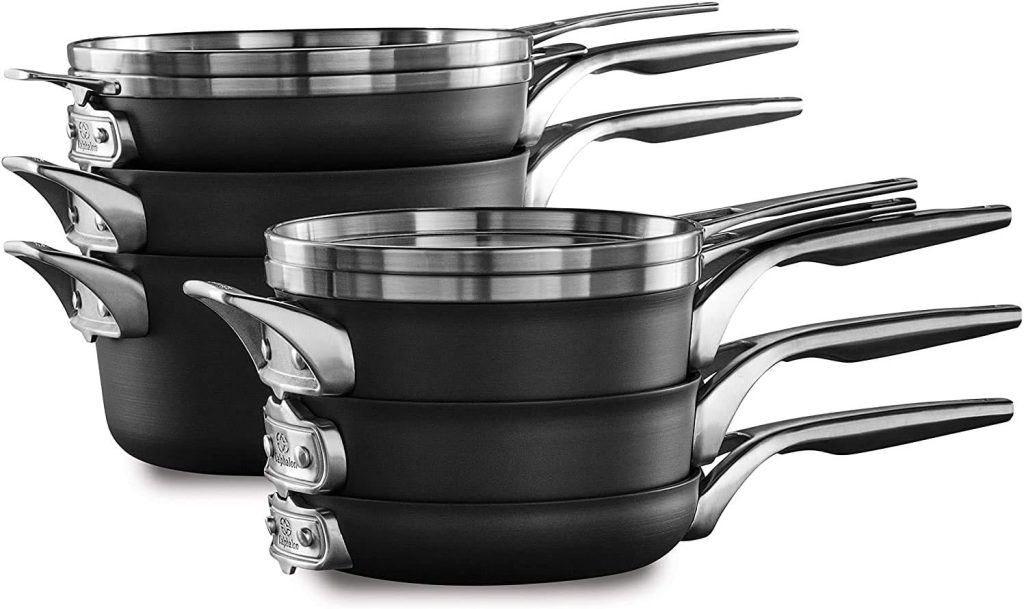
Calphalon’s space-saving design addresses the primary challenge of RV cooking: storage. The unique nesting system and premium nonstick surface make this set ideal for space-conscious RVers who refuse to compromise on quality.
What Makes It Special: The proprietary nesting design allows the entire set to stack in 30% less space than traditional cookware. Three layers of nonstick coating provide exceptional release and durability. The heavy-gauge aluminum construction ensures even heating throughout.
Performance on Gas Stoves: Heat distribution is excellent thanks to the heavy-gauge aluminum base. The nonstick surface performs consistently across all temperature ranges. Temperature responsiveness is immediate, perfect for gas stove cooking techniques.
Pros:
- Unique space-saving nesting design
- Triple-layer nonstick coating
- Heavy-gauge aluminum for even heating
- Oven safe to 400°F
- Dishwasher safe
- Lifetime warranty
Cons:
- Premium price for nonstick cookware
- Coating requires careful maintenance
- Heavier than standard nonstick sets
Real User Experience: A space-conscious RVer noted: “The nesting feature freed up an entire cabinet in our RV. The cooking performance is outstanding, and after three years, the nonstick coating still looks new with proper care.”
Best For: Space-conscious RVers with medium to large budgets, those who frequently cook complex meals, quality-focused travelers.
10. GSI Outdoors Glacier Stainless Steel Cookset
Rating: ⭐⭐⭐⭐ (4.3/5) Price Range: $80-$110
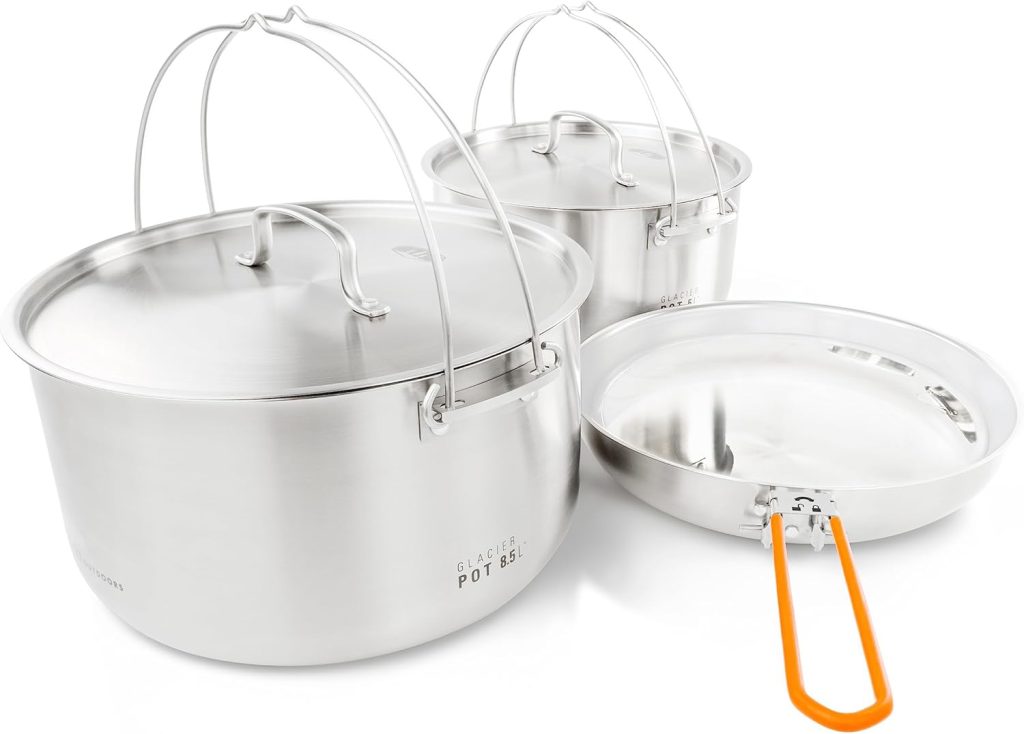
The GSI Glacier set brings outdoor-tested durability to RV kitchens at an accessible price point. Designed for rugged use, this stainless steel set offers excellent performance without breaking the budget.
What Makes It Special: The 18/8 stainless steel construction provides corrosion resistance and durability. The SureLock folding handles lock securely in place during cooking and fold for compact storage. The set includes a strainer lid and cutting board for added functionality.
Performance on Gas Stoves: The thick aluminum base ensures even heat distribution across gas burners. Heat retention is excellent for energy-efficient cooking. The stainless steel surface develops natural nonstick properties with proper seasoning.
Pros:
- Durable stainless steel construction
- Folding handles save space
- Includes useful accessories
- Excellent value for stainless steel
- Easy to clean and maintain
- Suitable for all heat sources
Cons:
- No nonstick coating
- Requires proper cooking technique
- Handles can get warm
Real User Experience: A weekend camping family shared: “This set handles everything from pancakes to pasta. The folding handles are brilliant for storage, and the stainless steel surface gets better with use. Great value for families.”
Best For: Families on a budget, weekend RVers, those who prefer stainless steel over nonstick coatings.
11. Rachael Ray Cucina Nonstick Cookware Set
Rating: ⭐⭐⭐⭐ (4.2/5) Price Range: $120-$150
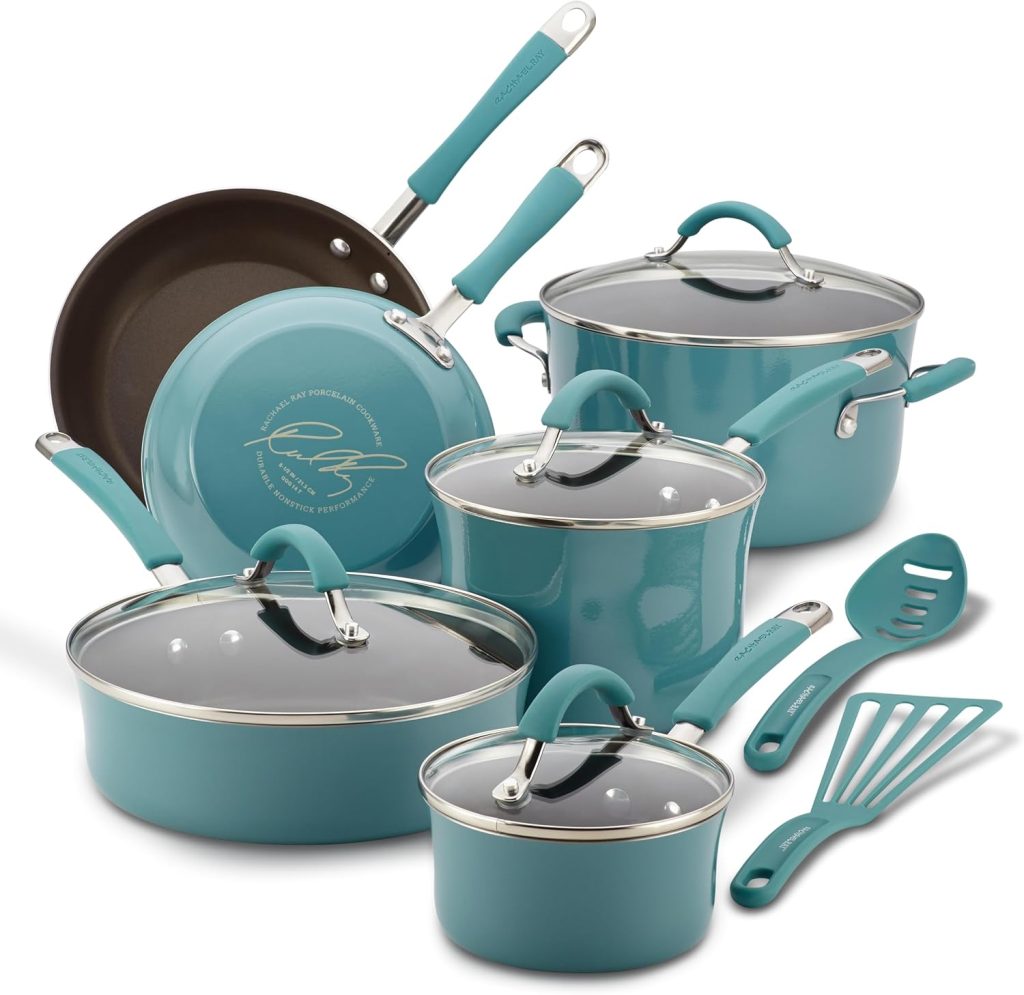
Rachael Ray’s Cucina set brings colorful style and reliable performance to RV kitchens. The rustic design and solid aluminum construction make this set both functional and attractive.
What Makes It Special: The rustic aluminum construction provides excellent heat conduction while maintaining affordability. Dual-riveted silicone handles offer comfortable grip and oven safety. The PFOA-free nonstick coating ensures easy cooking and cleanup.
Performance on Gas Stoves: Aluminum construction heats quickly and evenly on gas burners. The nonstick surface performs well for most cooking tasks. Heat responsiveness is good, though not as precise as tri-ply construction.
Pros:
- Attractive rustic design
- Solid aluminum construction
- Comfortable silicone handles
- PFOA-free nonstick coating
- Reasonable price point
- Oven safe to 400°F
Cons:
- Not as space-efficient as nesting sets
- Nonstick coating durability varies
- Limited to medium-heat cooking
Real User Experience: A style-conscious RVer mentioned: “We wanted cookware that looked good in our RV kitchen. The Cucina set is both functional and beautiful. The cooking performance is solid for the price.”
Best For: Style-conscious RVers, those wanting attractive cookware, moderate budgets.
12. Primus PrimeTech Stove Set 1.3L
Rating: ⭐⭐⭐⭐ (4.4/5) Price Range: $90-$120
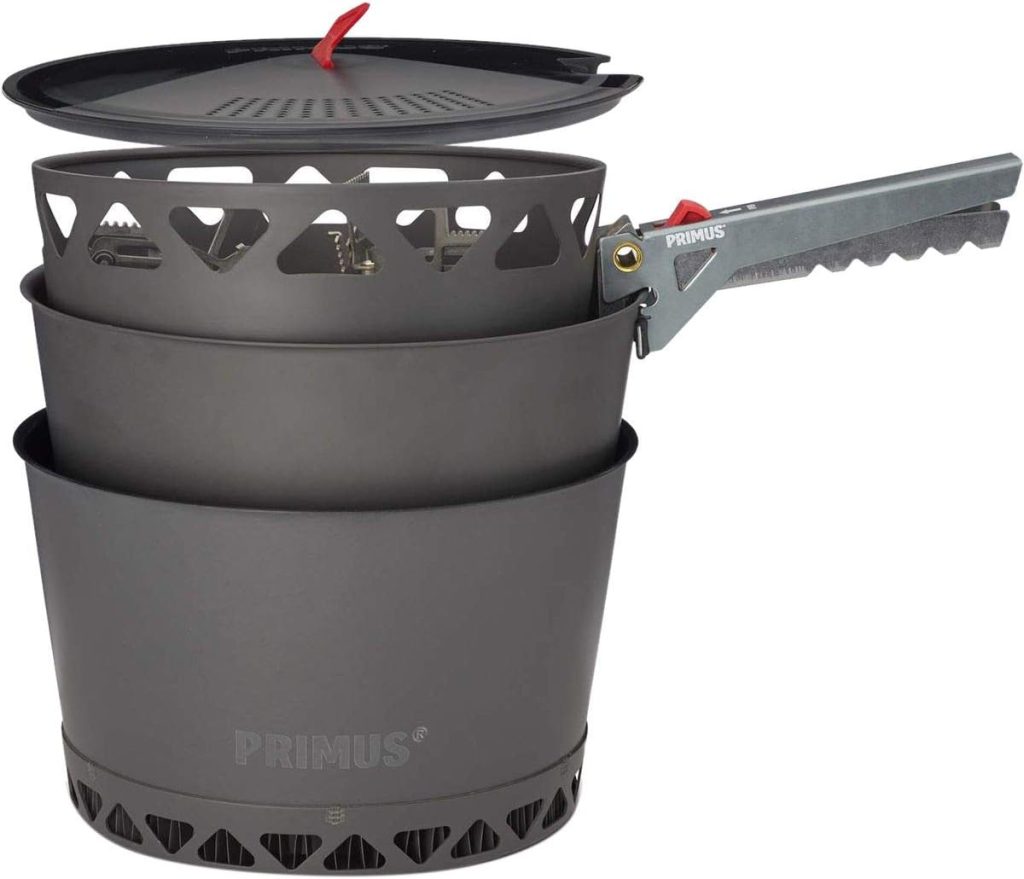
The Primus PrimeTech set exemplifies Scandinavian design and engineering, offering exceptional efficiency and compactness for space-conscious RVers.
What Makes It Special: The integrated heat exchanger dramatically improves fuel efficiency, crucial for extended off-grid adventures. The hard-anodized aluminum construction provides excellent durability while maintaining minimal weight. The entire set packs into the largest pot.
Performance on Gas Stoves: The heat exchanger technology maximizes heat transfer from gas flames, reducing cooking times significantly. Even heat distribution prevents hot spots. The lightweight design makes handling easy and safe.
Pros:
- Integrated heat exchanger for fuel efficiency
- Ultra-compact nesting design
- Lightweight yet durable
- Excellent heat distribution
- Includes plates and utensils
- Proven in extreme conditions
Cons:
- Limited capacity for large families
- Premium price for aluminum
- Heat exchanger requires careful cleaning
Real User Experience: An off-grid RVer reported: “The fuel efficiency is incredible. We can cook elaborate meals while using half the propane. The compact size means we have room for other gear.”
Best For: Off-grid enthusiasts, fuel-conscious RVers, those prioritizing efficiency and compactness.
13. Camco Stainless Steel Nesting Cookware Set
Rating: ⭐⭐⭐⭐ (4.1/5) Price Range: $150-$200
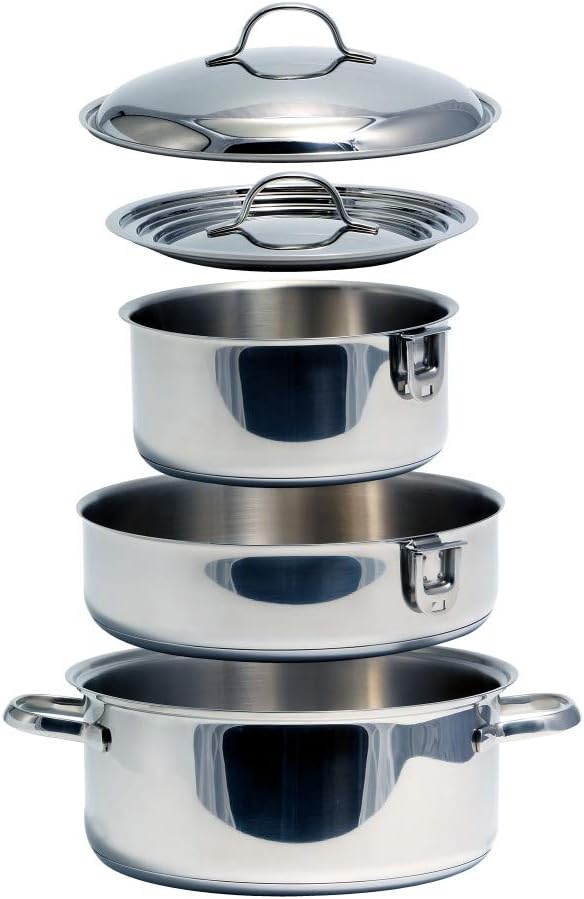
Camco, a trusted name in RV accessories, offers a purpose-built cookware set designed specifically for RV life. The nesting design and removable handles address the unique challenges of mobile cooking.
What Makes It Special: Designed specifically for RVs by RV specialists, this set understands the unique needs of mobile kitchens. The removable handles allow for versatile cooking and storage options. Stainless steel construction ensures longevity and easy maintenance.
Performance on Gas Stoves: The aluminum base provides good heat distribution for even cooking. Stainless steel surface is durable and non-reactive. Heat control is responsive to gas flame adjustments.
Pros:
- Designed specifically for RVs
- Removable handles for versatility
- Quality stainless steel construction
- Good nesting efficiency
- Reasonable price point
- Trusted RV brand
Cons:
- Handle system not as refined as premium brands
- Limited accessories included
- May require seasoning for best performance
Real User Experience: An RV dealer employee shared: “We sell a lot of these to new RVers. The quality is solid for the price, and customers appreciate that it’s made by an RV company that understands their needs.”
Best For: New RVers, those wanting RV-specific design, moderate budgets.
14. Cuisinart MCP-12N Multiclad Pro Stainless Steel Set
Rating: ⭐⭐⭐⭐ (4.3/5) Price Range: $200-$250
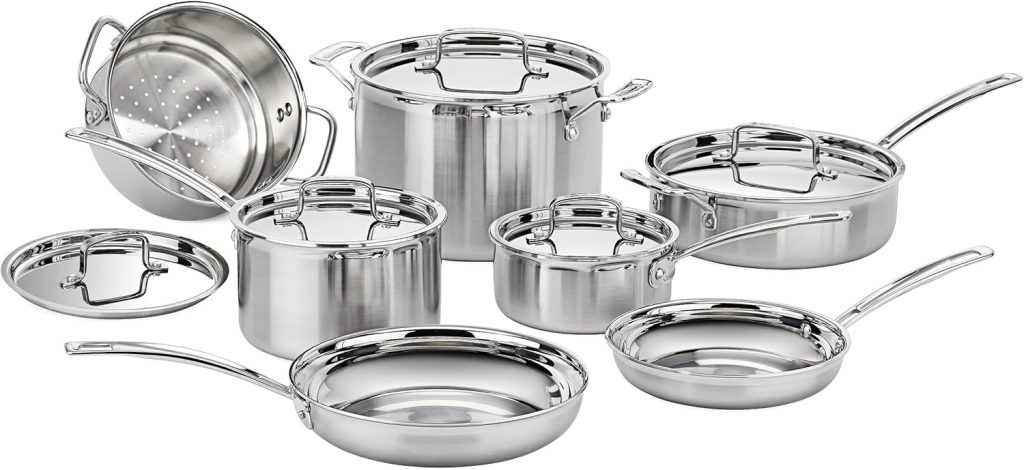
Cuisinart’s professional-grade construction meets RV practicality in this well-rounded set. The tri-ply construction and comprehensive piece selection make it suitable for serious cooking in mobile kitchens.
What Makes It Special: Triple-ply construction with aluminum core ensures professional-level heat distribution. The brushed stainless steel exterior hides fingerprints and scratches. Measurement markings inside pots help with precise cooking.
Performance on Gas Stoves: Excellent heat distribution eliminates hot spots common with gas cooking. Quick temperature response allows for precise cooking control. Heat retention is very good for energy-efficient cooking.
Pros:
- Professional tri-ply construction
- Measurement markings for precision
- Durable brushed finish
- Cool-grip handles
- Oven and dishwasher safe
- Good warranty coverage
Cons:
- Larger than space-optimized sets
- No nonstick coating
- Medium weight
Real User Experience: A cooking enthusiast noted: “This set performs like my home cookware. The heat distribution is perfect for delicate sauces, and the construction feels professional. Not the most compact, but worth it for cooking quality.”
Best For: Serious home cooks, those with adequate storage space, RVers prioritizing cooking performance.
15. HexClad Hybrid Nonstick Cookware Set
Rating: ⭐⭐⭐⭐ (4.4/5) Price Range: $300-$400
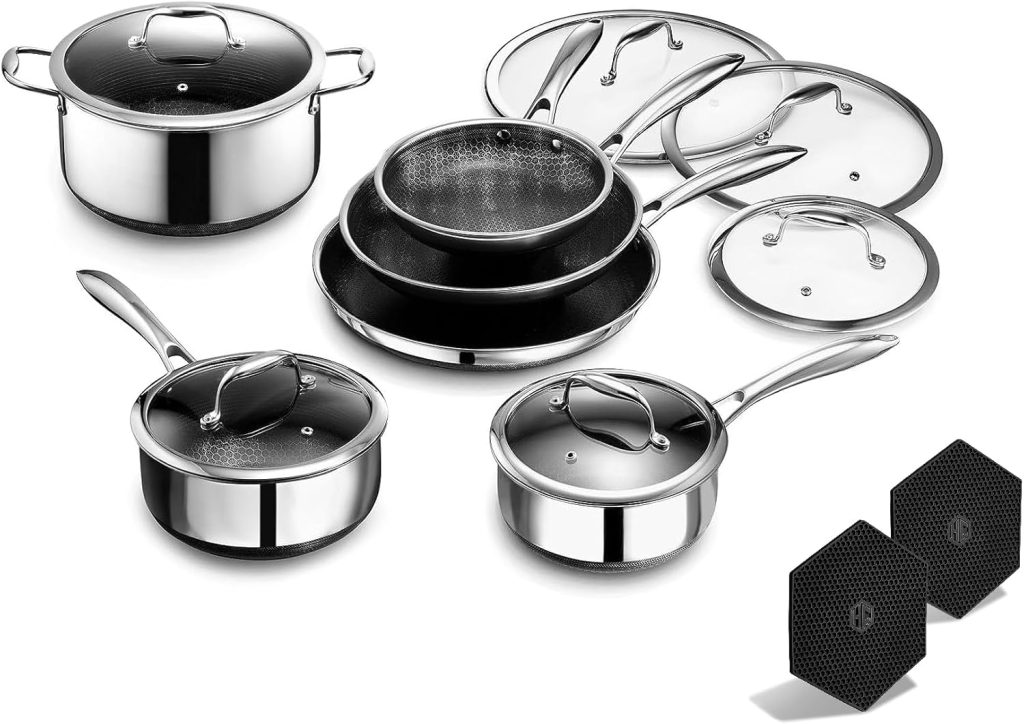
HexClad’s innovative hybrid technology combines the best of stainless steel and nonstick surfaces. The unique hexagonal pattern provides durability while maintaining easy release properties.
What Makes It Special: The patented hexagonal nonstick surface is laser-etched into stainless steel, creating a hybrid surface that’s both nonstick and metal utensil safe. Tri-ply construction ensures even heating, while the unique surface can handle high-heat cooking.
Performance on Gas Stoves: Exceptional heat distribution prevents hot spots. The hybrid surface allows for high-heat searing while maintaining nonstick properties for delicate foods. Temperature control is precise and responsive.
Pros:
- Unique hybrid nonstick/stainless technology
- Metal utensil safe
- High-heat capable
- Tri-ply construction
- Dishwasher safe
- Lifetime warranty
Cons:
- Premium price point
- Heavier than traditional nonstick
- Learning curve for optimal use
Real User Experience: A tech-savvy RVer reported: “The hybrid surface is amazing. We can sear steaks at high heat, then scramble eggs without oil. It’s like having two different pan types in one.”
Best For: Tech enthusiasts, those wanting the best of both worlds, RVers with higher budgets.
Complete Buying Guide for RV Gas Stove Cookware
Understanding RV Gas Stove Characteristics
RV gas stoves operate differently from home ranges, presenting unique considerations for cookware selection. Most RV stoves use smaller burners with less total BTU output than residential ranges, typically producing 6,000-9,000 BTUs per burner compared to 12,000-15,000 BTUs in home kitchens. This difference affects how cookware performs and which materials work best.
Gas flames provide instant heat control, but the smaller burner size means heat is concentrated in a smaller area. This can create hot spots in cookware that doesn’t distribute heat well. Understanding these characteristics helps explain why certain cookware materials and designs perform better in RV environments.
The confined space of RV kitchens also means that heat and humidity build up quickly during cooking. Cookware that requires less cooking time or lower temperatures helps maintain comfort inside the RV. Additionally, the limited ventilation in most RVs makes efficient cooking methods particularly important.
Essential Features for RV Cookware
Space Efficiency Storage space is the primary constraint in RV kitchens. Effective RV cookware must maximize storage efficiency through nesting designs, stackable construction, or removable handles. The best sets can reduce storage requirements by 50-70% compared to traditional cookware.
Nesting cookware allows smaller pieces to fit inside larger ones, creating a compact stack. This design is particularly effective for pots and pans of graduated sizes. Some sets include clever solutions like reversible lids that double as cooking surfaces or plates.
Detachable handle systems represent another approach to space saving. By removing handles, pots and pans can nest more efficiently and transition from stovetop to oven to refrigerator without transferring food. This system also allows for more flexible storage configurations.
Weight Considerations Every pound matters in an RV, affecting fuel economy, handling, and weight distribution. However, extremely lightweight cookware often sacrifices durability and cooking performance. The key is finding the optimal balance between weight, durability, and functionality.
Aluminum cookware offers the best weight-to-performance ratio for most RVers. Hard-anodized aluminum provides durability with minimal weight penalty. Stainless steel with aluminum cores offers professional performance with reasonable weight. Cast iron, while heavy, can replace multiple pieces and provides unmatched versatility.
Heat Distribution and Control Gas stoves require cookware with excellent heat distribution to prevent hot spots and ensure even cooking. Tri-ply construction with aluminum or copper cores provides the best performance. Single-layer aluminum pans can work but may develop hot spots over time.
Thick, flat bottoms are essential for good contact with gas burner grates. Warped or thin bottoms create uneven heating and can be dangerous on gas stoves. Quality cookware maintains its shape even after years of use and temperature cycling.
Durability and Maintenance RV cookware must withstand constant movement, temperature fluctuations, and potentially rough handling. Stainless steel and hard-anodized aluminum offer the best durability. Nonstick coatings can be convenient but may wear more quickly in RV environments due to space constraints and frequent handling.
Easy maintenance is crucial in RVs where water conservation and limited sink space make cleanup challenging. Smooth surfaces that release food easily and dishwasher-safe construction simplify the cleaning process.
Material Comparison for RV Use
Stainless Steel Stainless steel cookware offers exceptional durability and non-reactive cooking surfaces. It’s dishwasher safe, doesn’t require special care, and maintains its appearance indefinitely. However, stainless steel alone doesn’t conduct heat well, making tri-ply or impact-bonded aluminum construction essential for good performance on gas stoves.
The main advantages include longevity, easy maintenance, and professional appearance. Disadvantages include higher weight and the need for proper cooking techniques to prevent sticking. For RVers who prioritize durability and don’t mind a slight weight penalty, quality stainless steel sets provide decades of reliable service.
Hard-Anodized Aluminum Hard-anodized aluminum provides excellent heat conduction while maintaining reasonable weight. The anodizing process creates a hard, scratch-resistant surface that’s more durable than standard aluminum. This material responds quickly to temperature changes, making it ideal for gas stove cooking.
Benefits include superior heat distribution, lighter weight than stainless steel, and natural nonstick properties when properly seasoned. Drawbacks include the need for careful cleaning (no dishwashers for some sets) and potential reaction with acidic foods.
Nonstick Coatings Modern nonstick coatings have improved significantly in durability and safety. PFOA-free options address health concerns while providing easy cooking and cleanup. For RVers who cook frequently and want minimal cleanup, quality nonstick cookware can be an excellent choice.
Advantages include easy food release, minimal oil requirements, and quick cleanup. Disadvantages include coating wear over time, temperature limitations, and the need for gentle cleaning methods. Premium coatings like titanium-reinforced or ceramic options offer better durability.
Cast Iron Cast iron provides unmatched versatility and heat retention. A single cast iron Dutch oven can replace multiple pieces of cookware, making it attractive for space-conscious RVers. The superior heat retention allows for energy-efficient cooking once the desired temperature is reached.
Benefits include exceptional versatility, improves with use, works on any heat source, and lasts generations. Drawbacks include significant weight, maintenance requirements, and slow heating. For RVers who cook traditional foods and don’t mind the weight, cast iron offers exceptional value.
Size and Capacity Considerations
Selecting the right sizes depends on your typical group size and cooking style. Most RV cookware sets are designed for 2-4 people, which suits the majority of RV travelers. However, consider your specific needs carefully.
For couples, a basic set with 1-2 quart saucepans, a 3-quart pot, and 8-10 inch skillets handles most cooking needs. Families may need larger capacities and additional pieces. Weekend campers might prioritize minimal sets, while full-time RVers need comprehensive coverage.
Consider the size of your RV stove burners when selecting cookware. Pots and pans should match burner sizes for optimal efficiency. Oversized cookware on small burners leads to uneven heating and energy waste.
Special Features for RV Use
Induction Compatibility While most RVs use gas stoves, some newer models include induction cooktops or combination units. Induction-compatible cookware with magnetic bases provides flexibility for future upgrades or different cooking methods.
Oven Safety Many RV meals benefit from oven finishing or one-pot cooking. Oven-safe cookware up to 400°F or higher expands cooking possibilities. Removable handles allow stovetop pans to transition seamlessly to oven use.
Measurement Markings Interior measurement markings help with precise cooking when measuring cups might be stored elsewhere. This feature is particularly useful in compact RV kitchens where every tool must earn its space.
Non-Slip Bases Textured or weighted bases help cookware stay in place during travel and cooking. While most RVers secure cookware during travel, stable bases prevent sliding during food preparation and cooking.
Storage Solutions and Organization
Effective cookware organization multiplies your usable kitchen space. Vertical storage using dividers allows pans to stand on edge, using height instead of depth. Drawer systems provide better access than deep cabinets, especially for heavy items.
Protective padding prevents damage during travel and reduces noise from rattling cookware. Silicone mats or towels between pieces prevent scratching and provide cushioning during road vibrations.
Magnetic strips can secure lightweight lids or utensils to cabinet walls, freeing up drawer space. Some RVers install custom organizers with specific slots for each piece, ensuring everything has a designated place and travels securely.
Consider accessibility when organizing cookware. Frequently used items should be stored in easily accessible locations, while specialty pieces can occupy harder-to-reach spaces. This organization principle becomes crucial in compact RV kitchens where every cabinet access requires careful planning.
Budget Considerations and Value Analysis
RV cookware represents a significant investment, but the right choice provides years of reliable service. Budget considerations should include not just initial cost but long-term value, replacement frequency, and impact on cooking quality.
Budget Tier ($50-$150) Entry-level sets provide basic functionality at accessible prices. While these sets may not offer premium features or maximum durability, they can serve occasional RVers well. Look for basic aluminum construction with decent nonstick coatings and simple nesting designs.
Budget options often compromise on durability or features but can be perfectly adequate for light use. Consider starting with a basic set and upgrading individual pieces as needs become clearer through actual RV cooking experience.
Mid-Range Tier ($150-$300) This price range offers the best balance of features, quality, and value for most RVers. Sets in this category typically include space-saving designs, quality materials, and thoughtful features that address RV-specific needs.
Mid-range cookware often includes premium features like tri-ply construction, quality nonstick coatings, or innovative handle systems. These sets provide good durability while remaining accessible to most budgets.
Premium Tier ($300+) Premium cookware sets offer professional-grade performance, exceptional durability, and innovative features. These investments make sense for full-time RVers, serious cooks, or those who prioritize quality over initial cost savings.
Premium sets often include lifetime warranties, superior materials, and advanced engineering. While the initial investment is substantial, the long-term cost per use can be lower than repeatedly replacing budget cookware.
Maintenance and Care in RV Environments
RV cookware faces unique challenges that affect maintenance requirements. Limited water supplies, compact storage, and constant movement require specific care approaches to maximize cookware life.
Water Conservation Cleaning RV water tanks are finite, making efficient cleaning crucial. Pre-rinse with minimal water to remove food particles. Use biodegradable soap in small quantities. The “three-basin” method works well: wash, rinse, and sanitize using minimal water in each step.
Nonstick surfaces reduce cleaning requirements, often needing only a paper towel wipe for light cooking. Stainless steel may require soaking for stuck-on foods, but proper cooking techniques minimize this need.
Preventing Damage During Travel Cookware must be secured during travel to prevent damage from road vibrations and sudden stops. Never leave loose items in cabinets during travel. Use dividers, padding, or custom restraints to prevent movement.
Stack cookware carefully with protection between pieces. Nesting sets often include protective elements, but additional padding may be necessary. Heavy items like cast iron should be stored low and secured independently.
Dealing with Limited Storage Space Maximize vertical space using dividers or organizers. Store lids separately if space is tight—many can hang on cabinet doors or walls. Consider dual-purpose items that serve multiple functions.
Regular organization reviews help optimize space usage. As cooking habits develop, storage needs may change. Be willing to relocate items or reorganize systems to improve efficiency.
Climate and Environmental Considerations
RV travel exposes cookware to various climates and conditions that can affect performance and durability. Understanding these factors helps in both selection and care.
Temperature Extremes Cookware stored in RVs experiences significant temperature swings. Metal expansion and contraction can stress handles and joints. Quality construction with proper materials selection minimizes these effects.
Nonstick coatings can be particularly sensitive to temperature extremes. High summer temperatures in stored RVs can damage some coatings. Proper ventilation and storage practices help protect cookware investments.
Humidity and Corrosion Coastal travel and humid climates increase corrosion risks, particularly for basic aluminum and steel. Stainless steel and hard-anodized aluminum resist corrosion better. Proper drying before storage prevents moisture-related damage.
Silica gel packets in storage areas help control humidity. Ensure cookware is completely dry before closing cabinets, as trapped moisture accelerates corrosion and can create odors.
Altitude Effects on Cooking High-altitude cooking requires adjustments in technique and equipment. Water boils at lower temperatures, affecting cooking times and techniques. Cookware with excellent heat distribution becomes even more important at altitude.
Gas stoves may burn less efficiently at high altitude, making fuel-efficient cookware designs more valuable. Consider these factors if your travels include mountain regions or high-altitude destinations.
Frequently Asked Questions (FAQs)
General RV Cookware Questions
Q: How much should I expect to spend on quality RV cookware?
A: Quality RV cookware sets range from $100-$500, depending on materials, features, and brand. A good mid-range set ($150-$250) provides excellent performance and durability for most RVers. Premium sets ($300+) offer professional-grade performance and advanced features like superior space-saving designs or lifetime warranties.
Consider cookware as a long-term investment. A quality set can last decades with proper care, making the cost per use very reasonable. Budget sets may need replacement every few years, potentially costing more long-term.
Q: What’s the most important feature to look for in RV cookware?
A: Space efficiency is typically the most important feature, followed closely by heat distribution quality. RV kitchens have severely limited storage, so cookware that nests efficiently or features removable handles provides the biggest impact on daily life.
However, don’t sacrifice cooking performance entirely for space savings. The best RV cookware balances space efficiency with good heat distribution and durability. Consider your cooking style and storage limitations to determine the optimal balance.
Q: Can I use my regular home cookware in my RV?
A: You can use home cookware in your RV, but it’s often not optimal. Home cookware is typically designed for spacious kitchens with unlimited storage. In RV environments, space-optimized designs provide significant advantages.
That said, if you have quality home cookware that fits your RV storage and meets your needs, there’s no requirement to replace it immediately. Many RVers start with existing cookware and upgrade to RV-specific options as they identify limitations.
Q: Is nonstick or stainless steel better for RV cooking?
A: Both have advantages for RV cooking. Nonstick cookware offers easy cleanup and requires less water for washing, crucial advantages in RVs. It also needs less oil, making meals healthier and reducing cleanup further.
Stainless steel offers superior durability and doesn’t require replacement of worn coatings. It can handle higher temperatures and metal utensils. For most RVers, a combination approach works well: nonstick for everyday cooking and stainless steel for durability and versatility.
Q: How do I prevent cookware from moving around while driving?
A: Secure all cookware before travel using dividers, padding, or restraint systems. Never leave loose items in cabinets during travel. Many RVers use custom organizers, bungee cords, or foam padding to prevent movement.
Nesting cookware naturally stays together during travel. Separate pieces need individual securing or organization systems. Some RVers remove cookware entirely and store it in dedicated travel containers.
Gas Stove Specific Questions
Q: Why do some pans work better on gas stoves than others?
A: Gas stoves heat unevenly compared to electric or induction cooktops. Flames heat the bottom center of pans most intensely, creating hot spots if the cookware doesn’t distribute heat well. Quality cookware with aluminum cores or thick, conductive bases spreads this heat evenly across the cooking surface.
Thin or poor-quality cookware may develop hot rings matching the burner pattern, leading to uneven cooking and potential food burning. Tri-ply construction or impact-bonded aluminum bases solve this problem by conducting heat laterally across the pan bottom.
Q: What size cookware works best with RV gas burners?
A: Most RV gas burners are 6-8 inches in diameter. Cookware that matches or slightly exceeds burner size provides optimal efficiency. Pans much larger than the burner create uneven heating, while very small pans waste energy.
A 10-inch skillet typically works well on most RV burners, providing good cooking surface while maintaining efficient heating. Larger pans can work but may require moving food around to ensure even cooking.
Q: How do I adjust cooking techniques for gas stoves?
A: Gas stoves require more active temperature management than electric stoves. Learn to use medium and medium-low settings for most cooking, as high heat can create hot spots and uneven cooking.
Preheat cookware properly before adding food. Gas flames heat unevenly initially, so allow time for heat to distribute through quality cookware. Use visual cues and experience to judge temperatures rather than relying solely on burner settings.
Storage and Organization Questions
Q: What’s the best way to organize cookware in a small RV kitchen?
A: Vertical storage maximizes space efficiency. Use dividers to store pans on edge rather than stacked flat. This approach provides easier access and uses height instead of depth.
Designate specific storage for each piece to prevent searching and disorganization. Frequently used items should be most accessible, while specialty pieces can occupy less convenient spaces. Consider pull-out drawers or organizers that provide full access to stored items.
Q: How can I maximize storage space with my cookware?
A: Choose nesting or stackable designs as your primary space-saving strategy. Detachable handle systems can reduce storage volume by 40-60%. Use lid storage solutions like door-mounted racks or magnetic strips.
Consider multi-purpose pieces that serve multiple functions. A large skillet with a lid can serve as a serving dish. Dutch ovens can replace multiple pots and pans. Efficient sets might include only 3-4 pieces that handle all cooking needs.
Q: Should I secure cookware while traveling?
A: Absolutely. Unsecured cookware creates safety hazards and damage risks. Use positive latches on all cabinets containing cookware. Install dividers or restraints to prevent movement within cabinets.
Some RVers remove all cookware and store it in dedicated travel containers or cushioned boxes. This approach provides maximum protection but requires more setup and breakdown time at each location.
Maintenance and Care Questions
Q: How do I clean cookware with limited water in my RV?
A: Pre-plan efficient cleaning by cooking methods that minimize cleanup. Use parchment paper or silicone mats to reduce direct food contact. Clean as you cook when possible, addressing spills immediately.
Use minimal water cleaning techniques: scrape thoroughly before washing, use small amounts of hot soapy water, and rinse efficiently. Paper towels can remove most residue before washing. Consider waterless cleaning products for minimal water situations.
Q: How do I maintain nonstick coatings in RV environments?
A: Protect nonstick surfaces from scratches using proper utensils and storage padding. Avoid extreme temperatures that can damage coatings. Clean gently with soft sponges and mild detergents.
Temperature cycling from storage to cooking can stress nonstick coatings. Allow cookware to reach room temperature before heating when possible. Store with protection between pieces to prevent coating damage.
Q: What’s the best way to prevent rust and corrosion?
A: Ensure cookware is completely dry before storage. Humid RV environments accelerate corrosion, especially in coastal areas. Use desiccants in storage areas if necessary.
Stainless steel and hard-anodized aluminum resist corrosion naturally. Basic aluminum and carbon steel require more careful moisture control. Season cast iron properly and maintain the protective coating.
Performance and Cooking Questions
Q: Why does my food cook unevenly on my RV gas stove?
A: Uneven cooking typically results from poor heat distribution in the cookware or incorrect burner sizing. Gas flames create concentrated heat that must be spread evenly by the cookware material and construction.
Upgrade to cookware with aluminum cores or tri-ply construction for better heat distribution. Ensure your cookware size matches your burner size reasonably well. Preheat cookware properly before adding food.
Q: Can I use high heat with RV cookware?
A: Most RV cookware can handle high heat, but it’s often unnecessary and can create problems. Gas stoves provide intense heat, so medium settings often provide adequate cooking temperatures.
Nonstick coatings may be damaged by excessive heat. Thin cookware can warp under high heat. Use high heat only when necessary for techniques like searing, and reduce heat once desired temperature is achieved.
Q: How do I prevent food from sticking without nonstick coating?
A: Proper heating and fat usage prevent sticking in stainless steel and aluminum cookware. Preheat the pan properly, add fat (oil or butter), then add food. The “mercury ball test” works well: when a drop of water forms a ball and rolls around the pan, it’s ready for fat.
Learn proper temperature control for different foods. Proteins need higher heat initially, then reduction. Vegetables often cook best at medium temperatures. Proper technique makes nonstick coatings unnecessary for most cooking.
Purchasing and Selection Questions
Q: Should I buy individual pieces or complete sets?
A: Complete sets often provide better value and ensure coordinated performance across all pieces. However, individual pieces allow you to select exactly what you need and potentially mix materials for optimal performance.
Consider starting with a basic set that covers essential needs, then adding specialty pieces as requirements become clear through actual RV cooking experience. This approach prevents over-buying while ensuring you have necessary basics.
Q: What brands are most reliable for RV cookware?
A: Established outdoor and marine cookware brands like Magma, GSI Outdoors, and Stanley understand the unique requirements of mobile cooking. Traditional cookware brands like All-Clad, Cuisinart, and Calphalon offer quality but may not include RV-specific features.
Look for brands that offer good warranty coverage and customer service. Cookware problems on the road need quick resolution, so responsive customer service can be crucial.
Q: How many pieces do I really need for RV cooking?
A: A basic functional set includes: one small saucepan (1-2 quart), one medium pot (3-4 quart), one large skillet (10-12 inch), and one smaller skillet (8-inch). This covers most cooking needs efficiently.
Additional pieces like stock pots, specialty pans, or extra sizes depend on your cooking style and group size. Start with basics and add pieces as specific needs arise through actual cooking experience.
Safety and Technical Questions
Q: Are there safety considerations specific to RV gas stove cookware?
A: Gas stoves require stable, flat-bottomed cookware to prevent tipping. Warped or uneven bottoms create instability and uneven heating. Ensure handles are positioned away from walkways in narrow RV kitchens.
Monitor cooking carefully, as gas flames can extend beyond pan bottoms and heat handles or sides. Use back burners when possible to reduce heat near the cook. Install and maintain proper ventilation to remove combustion gases and cooking vapors.
Q: Can cookware affect propane consumption?
A: Yes, significantly. Efficient cookware reduces cooking times and allows lower heat settings, both reducing propane consumption. Heat exchanger designs can improve efficiency by 20-30%.
Poor heat distribution cookware requires longer cooking times and higher heat settings, increasing fuel consumption. Lightweight aluminum heats quickly, while thick stainless steel retains heat longer, both contributing to efficiency in different ways.
Q: What about cookware for outdoor cooking over campfires?
A: Many RV cookware sets work well over campfires, but cast iron excels in this environment. Stainless steel handles high heat well. Avoid nonstick coatings near open flames, as extreme temperatures can damage coatings and create toxic fumes.
Consider dual-purpose cookware that works well on both RV gas stoves and campfires. Cast iron Dutch ovens, heavy stainless steel skillets, and outdoor-specific sets provide this versatility.
Advanced Tips for RV Cookware Success
Maximizing Cooking Performance
Heat Management Techniques Understanding heat management on gas stoves dramatically improves cooking results. Start with medium heat for most cooking tasks, adjusting up or down as needed. Gas flames provide instant response, allowing for precise control once you understand your cookware’s heat characteristics.
Preheat cookware properly before adding ingredients. Quality cookware with good heat distribution needs adequate preheating to perform optimally. This is especially important for achieving proper searing or preventing sticking in stainless steel pans.
Use residual heat for energy efficiency. Turn off gas flames slightly before food is fully cooked, allowing residual heat to finish the cooking process. This technique works particularly well with thick-bottomed cookware that retains heat effectively.
Multi-Tasking Strategies RV cooking benefits from techniques that maximize efficiency and minimize cleanup. One-pot meals reduce water usage and simplify preparation. Sheet pan dinners work well in RV ovens, cooking entire meals simultaneously.
Use cookware versatility creatively. Large skillets can serve as serving platters. Dutch ovens can bake, roast, and serve as serving dishes. This approach reduces the need for separate serving pieces and maximizes functionality from each item.
Ingredient Preparation Efficient ingredient preparation becomes crucial in compact RV kitchens. Pre-cut vegetables when space allows, storing them in stackable containers. This approach reduces cooking time and active kitchen workspace needs.
Consider par-cooking ingredients that can be finished quickly during meal preparation. Pre-cooked grains, blanched vegetables, and prepared proteins allow for quick assembly meals that don’t overwhelm small cooking spaces.
Storage Optimization Strategies
Cabinet Organization Systems Install adjustable dividers to create custom storage spaces for your specific cookware. Vertical storage uses height efficiently, allowing pans to stand on edge. This approach provides easier access and better space utilization than traditional stacking.
Consider pull-out drawers or sliding organizers that bring stored items to you. Deep cabinets in RVs can hide items in the back, making them effectively unusable. Accessibility improvements make smaller storage spaces more functional.
Weight Distribution Heavy cookware like cast iron should be stored low and centered to maintain RV stability and handling. Distribute weight evenly across the RV to prevent handling issues or mechanical stress.
Consider the cumulative weight of your cookware collection. While individual pieces may seem reasonable, complete sets can add significant weight. Balance cooking needs with weight restrictions, especially in smaller RVs with lower weight capacities.
Travel Security Develop pre-travel checklists that include cookware securing. Loose items become projectiles during sudden stops or accidents. Test your securing systems during initial trips to identify weaknesses before they cause problems.
Use positive latches on all cabinets containing cookware. Magnetic or friction latches may not be adequate for heavy items during rough roads. Install additional restraints for valuable or dangerous items like knives or heavy pots.
Seasonal Considerations
Summer Cooking Strategies Hot weather cooking requires different approaches and cookware considerations. Nonstick surfaces reduce cooking times and heat generation. Quick-cooking methods minimize interior heat buildup.
Consider outdoor cooking options that move heat generation outside the RV. Portable gas burners, griddles, or grills can handle heat-generating tasks while keeping the interior comfortable.
Winter Challenges Cold weather affects gas pressure and stove performance. Quality cookware with good heat retention becomes more important when outdoor temperatures drop. Thick-bottomed pans maintain consistent temperatures despite varying gas pressure.
Condensation becomes a bigger issue in cold weather, requiring more attention to proper ventilation and moisture control. Ensure cookware is thoroughly dry before storage to prevent freeze damage or corrosion.
Altitude Adjustments High-altitude cooking requires technique adjustments that quality cookware facilitates. Water boils at lower temperatures, affecting cooking times and methods. Excellent heat distribution becomes even more critical for consistent results.
Consider altitude effects when selecting cookware materials. Aluminum responds quickly to temperature changes, helpful at altitude. Heavy heat retention materials like cast iron provide stability when atmospheric pressure affects cooking performance.
Specific Cookware Recommendations by RV Type
Class A Motorhomes
Large Class A motorhomes often feature residential-style kitchens with standard gas ranges. These RVs can accommodate larger cookware sets and may not require the extreme space optimization needed in smaller RVs.
Recommended Approach: Focus on quality over space savings, as storage is typically adequate. Professional-grade tri-ply stainless steel sets provide excellent performance. Consider keeping some home cookware if it performs well and fits available storage.
Weight is still a consideration, but less critical than in smaller RVs. Quality materials and construction become primary selection criteria. Look for sets that provide comprehensive coverage for serious cooking needs.
Class B and C Motorhomes
Medium-sized RVs balance space constraints with cooking needs. Cookware selection should emphasize efficient storage while maintaining good cooking capability.
Recommended Approach: Nesting sets with quality construction provide the best balance. Consider detachable handle systems for maximum space efficiency. Focus on versatile pieces that serve multiple functions.
Weight becomes more important than in Class A units. Look for aluminum construction with good performance characteristics. Avoid extremely heavy items unless they provide exceptional versatility.
Travel Trailers and Fifth Wheels
Towable RVs often have compact kitchens with significant space constraints. Cookware selection must prioritize space efficiency while maintaining reasonable cooking capability.
Recommended Approach: Maximize space-saving features through nesting designs and removable handles. Consider quality over quantity, choosing fewer pieces that handle multiple cooking tasks. Evaluate weight impact on towing capacity.
Focus on essential pieces that cover the widest range of cooking needs. A well-chosen 4-6 piece set can handle most cooking requirements while fitting in minimal space.
Truck Campers and Small RVs
The most space-constrained RVs require aggressive space optimization in cookware selection. Every piece must justify its space and weight.
Recommended Approach: Ultra-compact nesting sets or multi-function pieces provide maximum efficiency. Consider outdoor cooking options to supplement limited interior cooking capability. Prioritize lightweight materials unless weight savings sacrifice essential functionality.
Focus on pieces that serve multiple functions. A large skillet with lid can handle many cooking tasks. A quality Dutch oven can replace multiple pots and pans while providing superior versatility.
Maintenance and Longevity Tips
Preventive Care Strategies
Daily Maintenance Proper daily care extends cookware life significantly. Clean cookware promptly after use to prevent stuck-on food that requires aggressive scrubbing. Use appropriate utensils to prevent scratching or coating damage.
Store cookware properly with protection between pieces. Even small scratches accumulate over time, eventually affecting performance and appearance. Simple protective measures like towels or protective pads prevent damage.
Weekly Maintenance Perform deeper cleaning weekly to address buildup that daily cleaning misses. Stainless steel benefits from periodic polishing to maintain appearance. Nonstick surfaces need inspection for coating wear or damage.
Check securing systems and storage organization weekly. Road vibrations can loosen restraints or shift organization systems. Regular maintenance prevents small issues from becoming significant problems.
Seasonal Maintenance Comprehensive cookware inspection before and after storage prevents problems. Clean thoroughly before storage, ensuring no moisture remains. Apply protective coatings to cast iron or carbon steel before extended storage.
Inspect handles, hinges, and moving parts for wear or damage. Replace worn components before they fail completely. Many manufacturers provide replacement parts for quality cookware.
Troubleshooting Common Issues
Hot Spots and Uneven Cooking Hot spots usually indicate poor heat distribution in the cookware or mismatched pan-to-burner sizing. Verify that your cookware has adequate thermal conduction through aluminum cores or thick construction.
Adjust cooking techniques by moving food regularly or using lower heat settings. Some foods benefit from starting on higher heat, then reducing temperature for even cooking. Quality cookware minimizes but may not eliminate all hot spots on gas stoves.
Sticking Problems Food sticking to non-nonstick surfaces usually results from incorrect temperature or insufficient fat. Learn proper preheating techniques and use adequate cooking fat. Stainless steel requires different techniques than nonstick surfaces.
Temperature control becomes crucial for preventing sticking. Too high heat can cause proteins to bond to metal surfaces. Proper technique development eliminates most sticking issues even without nonstick coatings.
Handle and Hardware Issues Loose handles create safety hazards and should be addressed immediately. Most quality cookware uses replaceable hardware that can be tightened or replaced as needed. Carry basic tools for handle maintenance.
Detachable handle systems require periodic cleaning and lubrication to maintain smooth operation. Follow manufacturer recommendations for maintenance to ensure continued reliable operation.
Conclusion and Final Recommendations
Selecting the right cookware for your RV gas stove involves balancing multiple factors: space efficiency, cooking performance, durability, weight, and budget. The products reviewed in this guide represent the best options available in 2025, each excelling in different areas to meet various RV cooking needs.
For most RVers, the Magma Products A10-360L provides the best overall combination of quality, performance, and space efficiency. While the investment is substantial, the lifetime durability and superior performance justify the cost for serious RVers.
Budget-conscious travelers will find excellent value in the SENSARTE 17-Piece set with detachable handles. The innovative design provides premium features at an accessible price point, making quality RV cooking available to more travelers.
Space-critical situations benefit most from the GSI Outdoors Pinnacle Dualist HS, which maximizes functionality while minimizing storage requirements. The fuel efficiency features provide additional value for off-grid adventures.
Traditional cooking enthusiasts should consider the Lodge Cast Iron Dutch Oven Combo, which provides exceptional versatility and lifetime durability despite the weight penalty.
Key Takeaways for RV Cookware Selection
- Prioritize space efficiency through nesting designs or detachable handles
- Choose quality construction with good heat distribution for gas stoves
- Balance weight and performance based on your RV type and travel style
- Consider your cooking style when selecting features and materials
- Invest appropriately based on usage frequency and cooking importance
- Plan for maintenance requirements in RV environments
Final Thoughts
The right cookware transforms RV cooking from a necessary chore into an enjoyable part of the travel experience. Quality equipment enables restaurant-level meals in spectacular locations, creating memories that last far beyond the initial investment.
Consider your specific needs, budget, and cooking style when making selections. The products in this guide have been tested and proven in real RV environments, providing reliable performance for thousands of mobile cooks.
Remember that cookware is just one component of successful RV cooking. Proper techniques, quality ingredients, and creative meal planning work together with good equipment to create exceptional mobile dining experiences.
Whether you’re planning weekend adventures or embarking on full-time RV life, investing in appropriate cookware pays dividends in cooking enjoyment, meal quality, and overall travel satisfaction. Choose wisely, maintain properly, and enjoy the freedom to create delicious meals anywhere your adventures take you.
The open road awaits, and with the right cookware, every destination can offer the comfort and satisfaction of home-cooked meals. Safe travels and happy cooking!
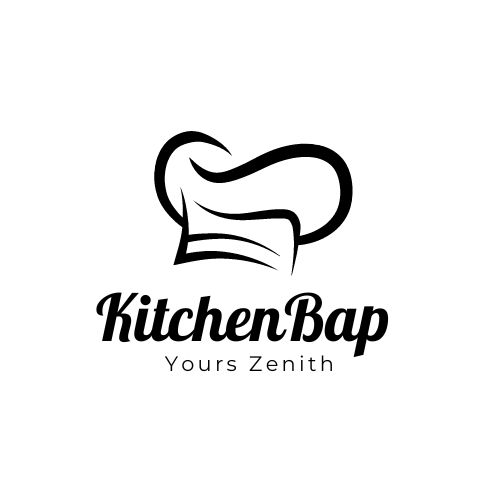
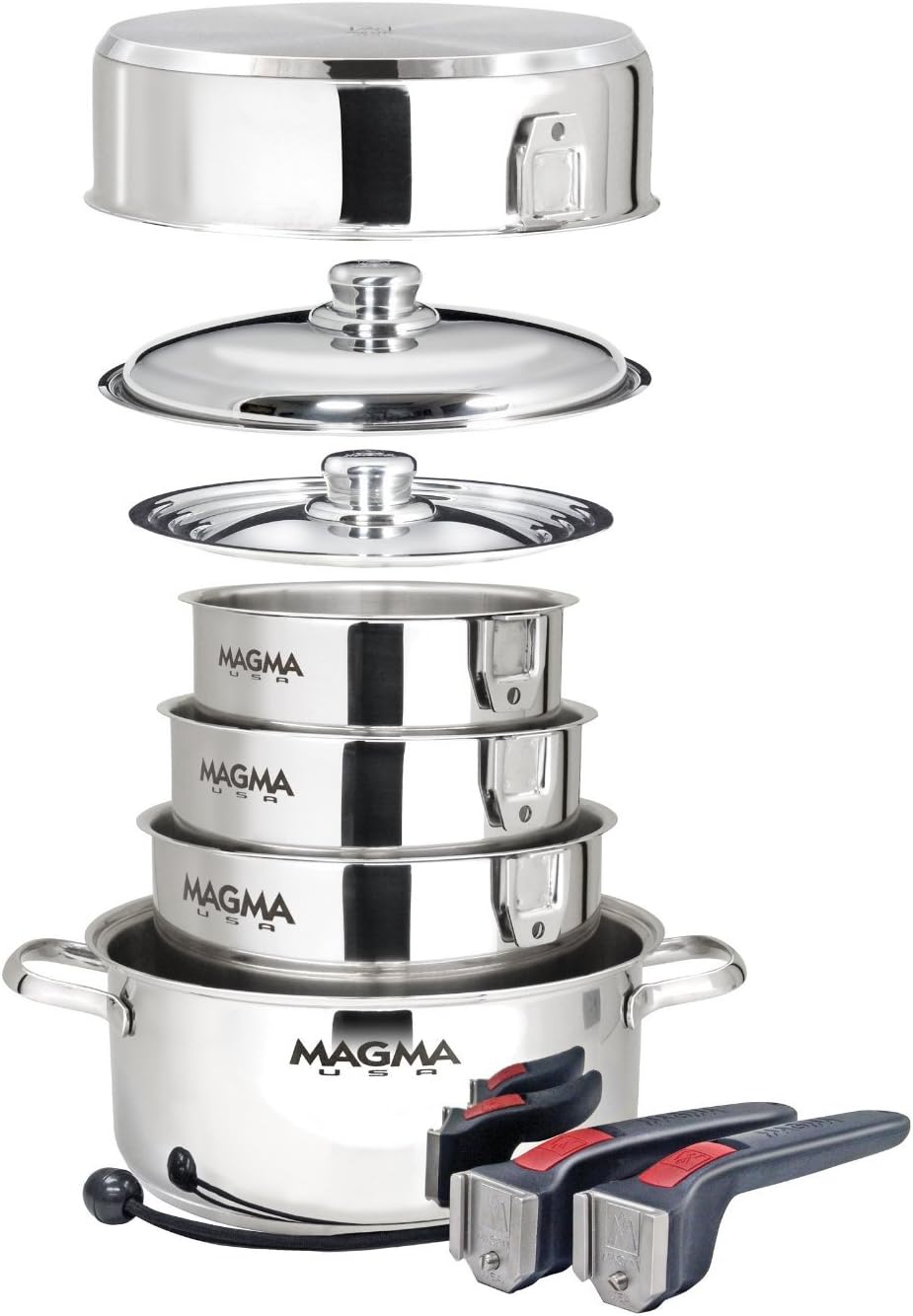

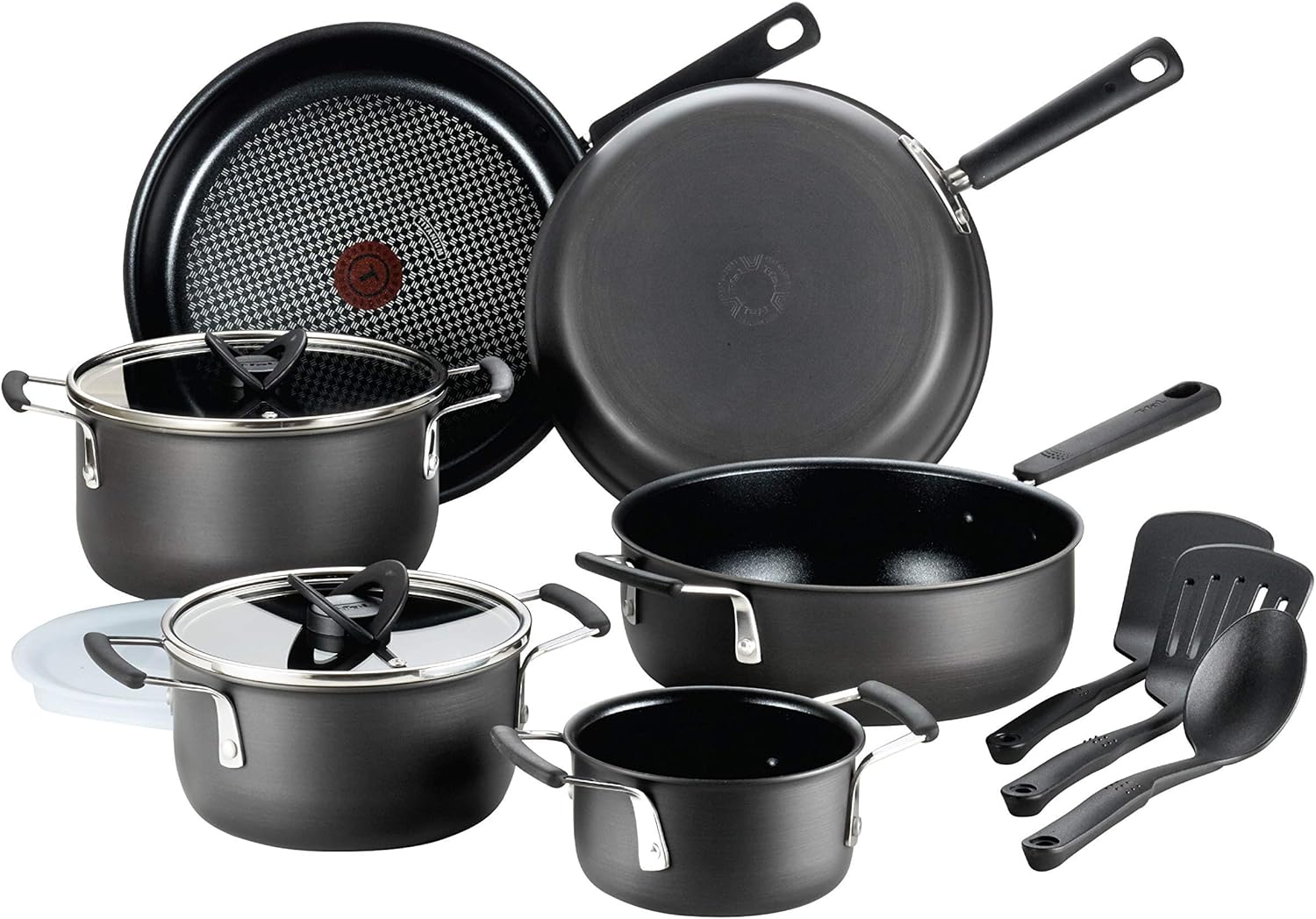

Leave a Reply